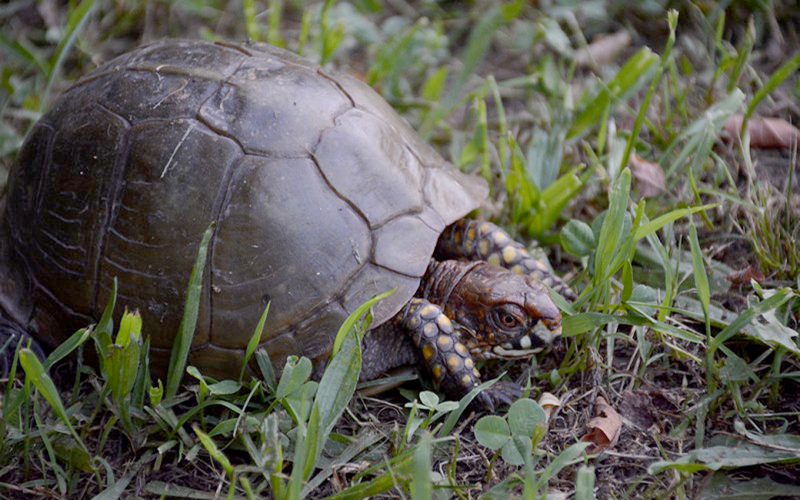
Staff Photo Amanda Bancroft
This three-toed box turtle was seen enjoying a mowed lawn near Fayetteville. The red eyes could indicate it’s a male, but females may have dark red eyes instead of the typical brown.
That little turtle you just passed on the way to work may be older than you! Three-toed Box Turtles (Terrapene carolina triunguis) have a life cycle which is shockingly mysterious and fascinating. Where one expected a simple mate-egg-hatch-grow process, there is humor, intrigue and art.
To determine the age of a box turtle, observe it like the stump of a tree: count its rings! There are growth rings, or small ridges radiating outward around the top of the shell, that are challenging but possible to count. Box turtles can live to be fifty years or older, with many becoming centenarians, and it’s difficult to determine their exact age once they get to be very old (the ridges are pressed very close together).
Where are all the baby box turtles? This is a question many scientists and lay people ask themselves, since newly hatched and very young turtles are secretive, supposedly hiding away in nobody-knows-where. Herps of Arkansas describes this as something of a mystery to science. We still don’t know with confidence how young turtles survive their first years.
It’s not always clear which turtles are male and which are female, especially when they’re juveniles. According to Herps of Arkansas and BoxTurtleWorld.com, there are a few differences that, when observed together (not singularly) can indicate the sex. Males generally have brighter colors and red eyes while females tend to be dull with brown eyes, but this is not always consistent. A male’s plastron, or the belly side of their shells, is usually concave to assist with mounting a female (who usually has a flat plastron), but not in every male. The tail is a good way to tell them apart: females appear to have smaller tails with vent openings closer to their bodies, while the male’s vent is further down towards the tail tip.
If you see turtles mating and think Aha! Now I know which one is which, well, think again: sometimes males mount other males or females mount females and males in dominance displays. But if you see a turtle laying eggs, she is obviously female. “You can also recognize a male if you see him ‘fanning.’ This is a display of his penis, usually in water or wet grass. The organ looks kind of like a dark bluish/purplish flower,” explains Box Turtle World. That’s a very aesthetically polite way of describing a sluggish display.
Sometimes, you might see a male upside down when mating – don’t be alarmed. While some tortoises can die on their backs, box turtles can usually right themselves using strong neck muscles with no interference from humans. Most of all, it’s important not to keep wild turtles as pets because the pet trade leads to population decline. Just enjoy their beauty and presence in nature as part of the mystery of living in the Natural State.
Amanda Bancroft is a writer, artist, and naturalist building an off-grid cottage for land conservation on Mt. Kessler. She and her husband Ryan blog about their adventures and offer a solar-hosted online educational center on how to make a difference with everyday choices at: www.RipplesBlog.org.










